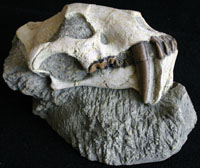Hoplophoneus primaevus belongs to an extinct family of carnivores called the Nimravidae. Nimravidae are related to the cats, civets, mongooses, and hyaenas.
Hoplophoneus, and Nimravedae, are not true cats. True cats have an external structure called an auditory bulla with two chambers, separated by a septum. This auditory bulla is a thin walled, rounded, bony, prominence that houses the ear bones. Nimravidae show no trace of this external bulla.
Its body is robust with short legs and neck and was about three and a half feet long. It was about one and a half times the size of a house cat.
The canine teeth of Hoplophoneus are fairly thin. They probably were not used to grab and hold its prey with. If its teeth were to become broken in a long struggle, the animals would probably have died of starvation fairly quickly and very few separated teeth have ever been found. Therefore, it probably used its teeth to slash and rip at its prey's throat or belly and then waited for the prey to die.
Hoplophoneus lived during the Oligocene (37.5-30 million years ago). The Oligocene marked the start of generalized cooling to the earth. Glaciers formed in Antarctica during the Cenozoic Era (65 million years ago to the present) for the first time. Tropical climates diminished and cooler woodland and grassland climates became more widespread. The cooling trend culminated in the Ice Age of the Pliocene (10-3 million years ago).
By the Oligocene, modern types of angiosperms (plants with an enclosed seed) had become widespread. The higher latitudes of the northern hemisphere would have changed from broadleafed trees to those found on the North Island of New Zealand or the tip of the Cape of South Africa.
Hoplophoneus is Latin for murderous weapon. In Latin primaevus means early or young.
The following is how Hoplophoneus primaevus is classified: Kingdom: Animalia, Phylum: Chordata, Class: Mammalia, Order: Carnivora, Family: Nimravidae, Genus: Hoplophoneus, Species: primaevus.
Hoplophoneus primaevus 
Quantity in Basket: None
Code: SKU-104
Price: $268.50
Shipping Weight: 2.58 pounds
Time: Oligocene, approximately 30 million years ago.
Location: White River Formation, Pennington County, South Dakota, USA.
Dimensions: 7"